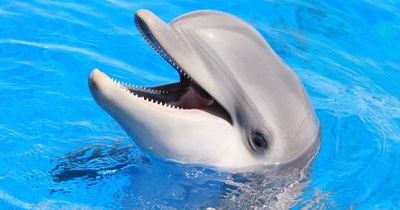Taxonomy
- Kingdom: Animalia
- Phylum: Chordata
- Class: Mammalia
- Order: Cetacea
- Suborder: Odontoceti
- Family: Delphinidae, Inidae, Lipotidae, Plantanstidae, Pontoporiidae.
0
0
Distribution and Habitat
- There are 42 species of dolphins found around the world. Of those, 38 are marine dolphins and 4 are river dolphins.
- Dolphins are found worldwide and thrive in shallow seas where weather is warm.
- Marine dolphins come from the family Delphinidae.
- The Bottlenose dolphin is the most common species and is found worldwide in tropical and temperate waters.
Physical Features
- Dolphins have streamlined bodies for fast swimming. They use their tail called “fluke” for propulsion while the pectoral fins together with the tail give directional control. The dorsal fin provides stability.
- Coloration of the skin varies depending on the species. The majority have different shades of gray. The Amazon River dolphin has pink coloration.
- Atlantic dolphins are born with about 80 to 100 cone shaped teeth but they don’t chew their food, they swallow it.
- The squeaks and whistles a dolphin makes come from their blowholes. They do not make noises with their mouths.
Size and Weight
- Dolphins vary in size depending on the species. The smallest is the Maui Dolphin, a subspecies of the Hector dolphin, at 4 f or 1.2 m in length and 90 lbs or 40 kg in weight. The largest is the Orca, also known as Killer Whale, at 30 f or 9.5 m in length and up to 19,000 lbs or 5,443 kg in weight.
Senses
- Dolphins use echolocation to make sense of their surroundings. They slap their nostrils together to produce a wave sound that creates an echo. This echo will give the dolphin an image of the object such as its shape, size and proximity.
- Dolphins can hear frequencies ten times above the upper limit of the adult human hearing.
- Their teeth are believed to function as antennae to receive sound.
- Dolphins lack olfactory nerves and it is believed that they have no sense of smell.
- To stay alert for predators, only half a dolphin’s brain goes to sleep.
Social Behavior
- Dolphins are highly social animals that live in pods of up to a dozen individuals. Where there is high concentration of food, hundreds can be found together.
- Pods vary in sizes and structure among species.
- Dolphins communicate using clicks, whistle sounds and vocalizations. They also use non verbal communication such as touching. Every dolphin has a signature whistle it uses to identify itself.
- Dolphins show playful behavior such as making bubble rings, leaping out of the water and passing along small animals to other members of the pod.
Breeding
- Mating season occurs throughout the year.
- Gestation period varies with species. For small dolphins it is usually from 11 to 12 months, for larger ones like the orca it is around 17 months.
- When giving birth females will distance themselves from the pod.
- Dolphins usually give birth to one calf and are born tail first.
The young
- A young dolphin is called calf.
- Newborn dolphins have a tiny patch of hair on their chins.
- Calves nurse from 1 to 2 years and will stay with their mothers until 3 to 8 years old depending on the species. During this time the calf will follow its mother and learn how to play and catch food.
Diet
- Diet will depend on the availability of food in the area. They generally eat fish, crustaceans, and squids. Larger dolphins such as the orca will also eat large and small marine mammals.
- Dolphins hunt for fish using echolocation.
- To hunt dolphins use a technique called bait balling. A pod of dolphins swim around a school of fish which makes them swim closer together forming a ball. The dolphins form a barrier preventing the fish from escaping and becoming easy prey.
- They also use a technique called corralling. When swimming in shallow waters dolphins chase the fish against a wall or into a narrow area where they are unable to escape.
- Dolphins consume from 2 to 10% of their total body weight each day.
Threats
- Dolphins suffer from a wide range of diseases and parasites.
- Dolphins have few natural predators, human threat is the most dangerous.
- River and sea pollution such as pesticides, plastic and heavy metals.
- Collisions with boat propellers are a common source of death.
- Dolphins get caught in nets used by fishermen causing injuries and death.
Additional Facts
- Dolphins are getting popularity in animal assisted therapy of mental and developmental disabilities.
- All dolphins belong to the cetacean family which includes whales, dolphins and porpoises.
- The name dolphin originates from the Greek “delphus” meaning “womb”. It can be interpreted as “fish” with a “womb”.
- A group of dolphins is called “school” or “pod”.
- Male dolphins are called “bulls” and females “cows”. Young dolphins are called “calves”.
Sources:
⇒University of California Museum of Paleontology – Introduction to the Cetacea
⇒Dolphin Communication Project – How echolocation works
⇒University of Michigan Museum of Zoology